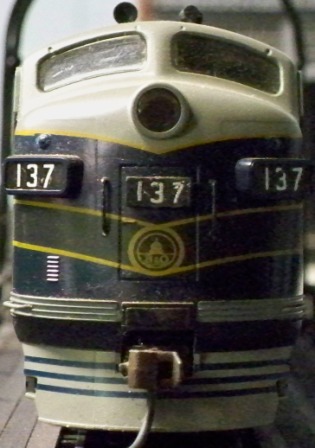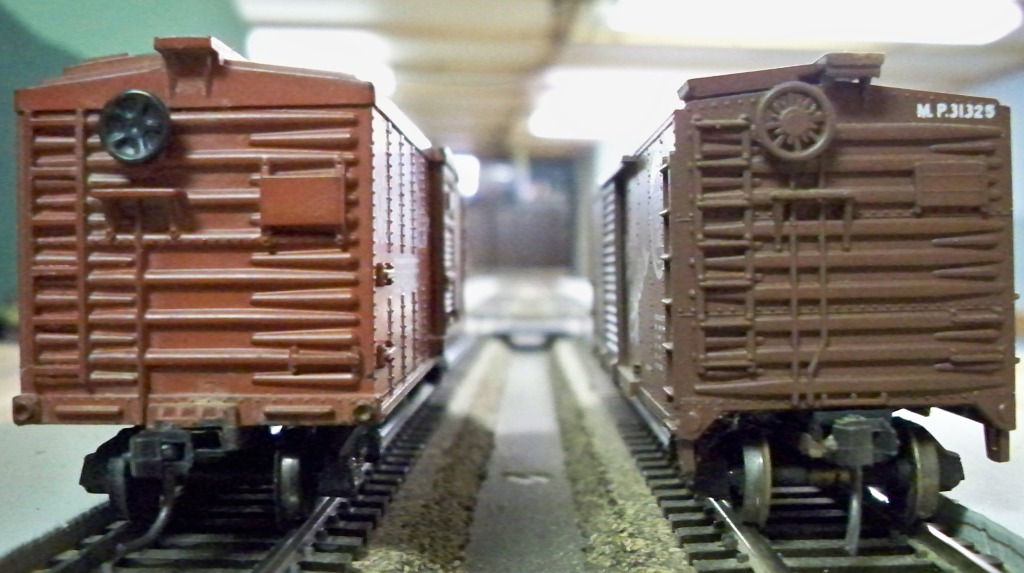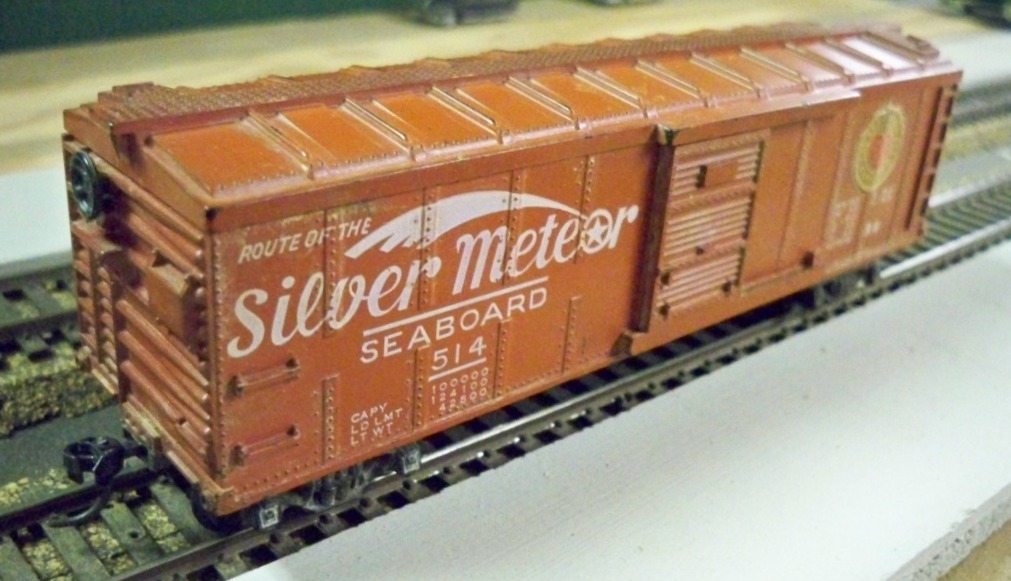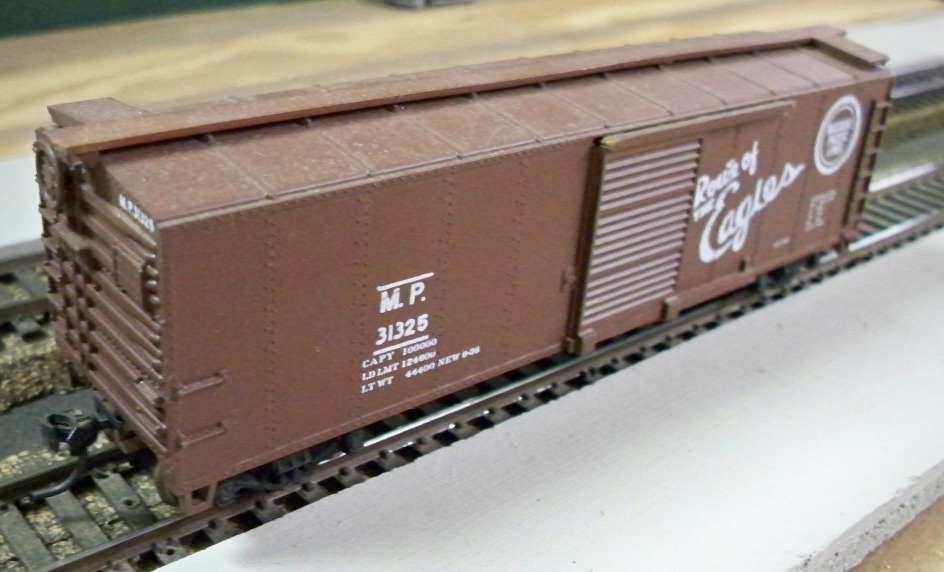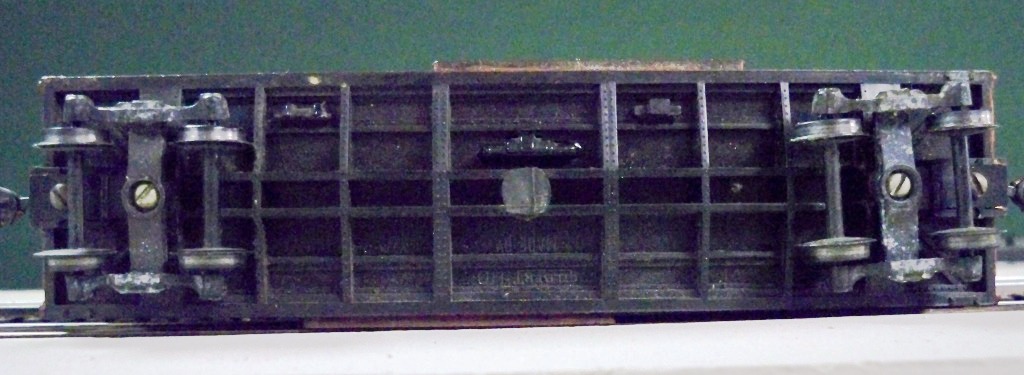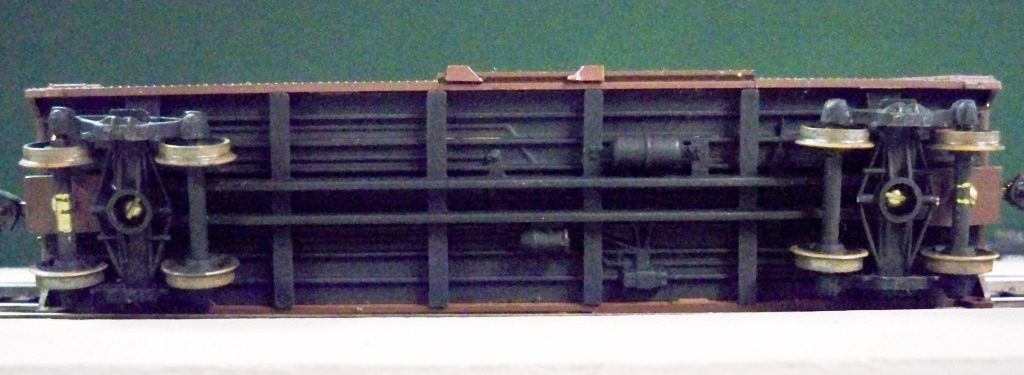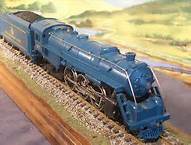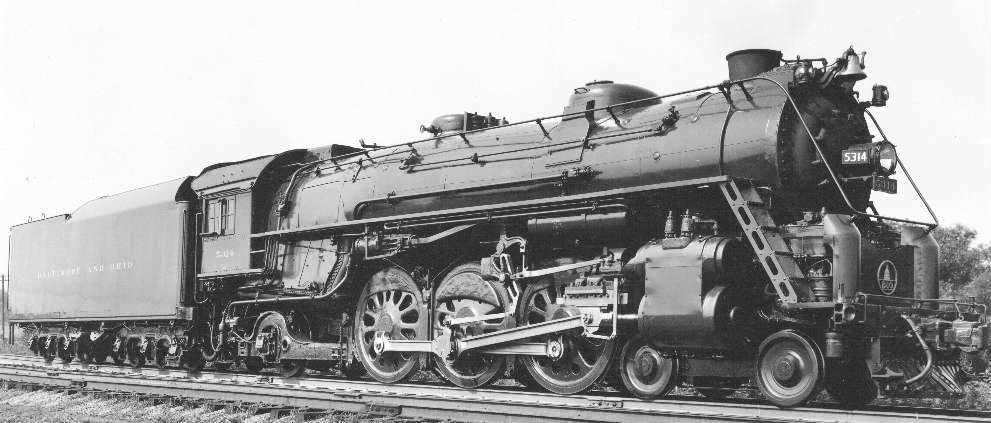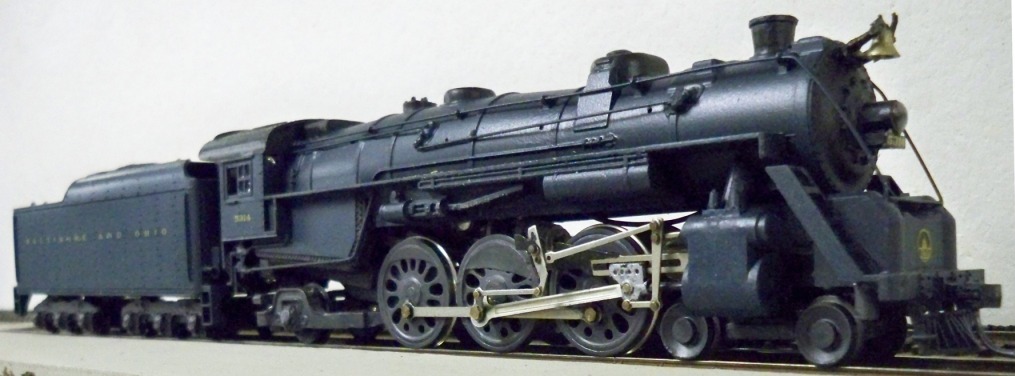This page contains information intended to help acquaint laymen and
neophytes with the basic terminology and practices of the model railroading
hobby. It is by no means a detailed "how-to" course, but only an
explanation of the basic aspects of the hobby, what is meant by certain terms,
and the rationale behind model-building and operation.
Frequently Misused or Misunderstood Terms
meet: A meet is a maneuver in which one train encounters and passes
another train headed in the opposite direction. (Compare: pass.)
pass: Pass has a couple of meanings:
1. A pass is a maneuver in which one train overtakes and passes another train
moving in the same direction. (Compare: meet.)
2. A pass is a card issued by a railroad authorizing someone to ride as a
passenger on the railroad, usually for a single trip or a limited series of
trips, either in performing a service for the railroad or as a guest of the
railroad.
prototype: With respect to modeling, a prototype is a real-world
object or process which is replicated, usually in miniature form, with varying
degrees of fidelity to the appearance and functionality of the original,
depending on the objective. Examples of modeling prototypes include
vehicles, rights of way, structures, scenery, control circuitry, operation
schedules and timetables, communications and dispatching procedures.
train: A train is any coupled assemblage of motive power and rolling
stock which has orders authorizing its operation on mainline or branch-line
trackage. A car or group of cars in a switching yard is not a train, and
a locomotive without train orders is not a train.
train set: There are two appropriate applications of this term, and
one common misapplication of it.
1. Referring to prototype and model railroads, a train set is a group of
matched cars used as a unit in a specific form of service. Examples are
the Burlington's early streamlined Zephyr, the five-car streamlined
heavyweight train sets of B&O's Cincinnatian, GM's Aerotrain, New York
Central's Xplorer, and the multi-car consist of the American Freedom Train.
Train sets of a different sort are used in freight service, such as unit coal
trains, whose couplers are designed to pivot for sequential rotary car-dumping
of the entire train, car by car, without uncoupling..
2. Referring to toy trains, a train set is a boxed group of a single
manufacturer's products, typically consisting of a locomotive, a few cars, and
a circle of track, designed and intended primarily for use by children, but
sometimes collected by adults.
3. Misapplication: A model railroad is not a "train
set." Model railroads typically operate several trains, the number and
content of which vary from hour to hour as individual cars are collected,
classified, coupled together, and hauled to an assigned destination, where the
process is reversed, and cars are distributed to industries and transfer
points—just as on a real railroad. A model railroad typically takes form
as a gradual accretion and adaptation of many materials and pieces of
equipment from a variety of sources; it is not a "set" in any sense of the
word. If you prefer a shorter term than "model railroad," "layout" or
"pike" will usually suffice.
Gauge or Scale?
What do the terms gauge and scale mean? Is there a
difference? What's a "ho" train?
Gauge: In railroad terms, gauge is simply the distance between
the inside edges of the tops of the track's two running rails. Obviously, this
distance must remain constant throughout any rail system, so as to match the
distance between the wheels on each axle of every car and locomotive that
rolls on the track. In Europe, North America, and much of the rest of
the industrialized world, the standard gauge for major railroads is 4
feet, 8 1/2 inches (56.5 inches, or 143.5 centimeters). Some low-budget
rail operations operate instead on narrow gauge, typically 3-foot or
1-meter gauges, but as narrow as 2-foot gauge in a few cases. Narrow
gauge both requires less real estate and permits tighter turns, and so is well
suited to logging and mining operations in mountainous territory, as well as
streetcar service. On the other hand, a few systems, such as the Trans-Siberian
Railway, went the other way, to a broad gauge of 5 feet or so. To
see how gauge translates into terms of toy and model railroads, however, we
first need to consider the issue of scale.
Scale: When we create a miniature reproduction of a
real-world object, such as a locomotive, we reduce all dimensions of the
original (called the prototype) by some fixed proportion (the
proportion of the prototype itself being 1:1). For
example, we might decide to build a miniature of such a size that each inch of
length on the model represents a foot of length on the prototype. In
that case, the ratio is 1:12, since there are 12 inches in 1 foot. If we
do this reduction precisely for every dimension of every part on the real
locomotive, then our model should look exactly like the prototype, only one
twelfth the actual size. If the prototype locomotive we're modeling is 50 feet long and 12 feet high, then our model will be
50 inches long and 12
inches high—uncomfortably large for indoor display, but usable outdoors in a
large back yard. Miniature railroads don't become convenient for indoor
use until the scale-to-prototype ratio gets down to the range of 1:24 (1/2
inch represents 1 foot) or below.
Gauge in Scale: Now, suppose we've created a model in a scale
of 1:32—that's 3/8" on the model representing 1' on the prototype. And
suppose we have the clever notion of turning it into an operating model, by
installing an electric motor and a few gears in it. If we want this scale miniature to
operate, and to do so reliably, then we must also create miniature track,
reduced from prototype dimensions by exactly the same proportion. If we
reduce the standard track gauge of 56.5 inches by a ratio of 1:32,
the railheads of our miniature track will be 1.77 inches apart. For all
practical purposes, we can call it 1-3/4 inches, and no one will notice the
difference. And that's precisely what early electric train manufacturers
did, dubbing the 1-3/4" rail spacing "#1 gauge."
Popular Scales: Later on, a scale of 1:48
(1/4
inch to the foot) was introduced. Unfortunately, this would have
translated into a track gauge of 1.177 inches, and at the time no one wanted
to bother with special measurements for a mere "toy." So a "close
enough" track gauge of 1-1/4 inches was settled upon,
and dubbed "#0 (zero) gauge." Number-0 gauge became the favorite of
toymakers and consumers for many years, from the 1930s into the 1960s. As a result,
the popular pronunciation of
#0 gauge (zero gauge) soon became the simpler "O gauge" ("oh" gauge),
and the official designation eventually followed suit.
O gauge turned out to be a convenient size for
home modelers to work in, so early precision model railroading evolved around
1:48 scale, with wheel and track gauge adjusted outward to the prevailing toy
standard of 1.25 inches (rather than try to buck established tradition).
Precision models built to 1:48 ratio were dubbed "O scale," distinguishing
them from their O gauge toy counterparts, whose modeling standards remained
relatively crude.
By the end of World War II, miniaturization and precision
machining had advanced to the stage that motors and mechanisms could fit into
models about half the size of O scale. A new scale called "HO"
(signifying "half-0," and pronounced "aitch-oh"—not "ho") was developed,
allowing more complex layouts to be built in the same space. HO's scale
ratio is a curious hybrid, with 3.5 millimeters on
the model representing 1 foot on the prototype, which translates to a ratio of
1:87. For this new scale, developers determined to reduce the prototype
track gauge by the same proportion as the rest of the model, to 0.650 inches
for standard gauge equipment and track.
As miniaturization evolved further, an even smaller scale, "N," about half
the size of HO, with a reduction ratio of 1:160 and a standard track gauge of
0.353 inches, became popular.
Other Scales: O, HO, and N are the most popular scales today;
however there are also in-between scales, such as 1:64 "S" (3/16" = 1'), 1:120 "TT" (1/10" = 1'),
and 1:220 "Z" (0.055" = 1'), which attract niche followings.
There are hobbyists currently active in S and Z scales, but TT lost popularity
after the introduction of N, and is seldom seen today.
At the larger end of the spectrum, G gauge is about the same size as the old #1
gauge, and suitable for outdoor use. G gauge contrasts with O and HO
scales, in that it uses the same track rail spacing (45 millimeters) for both standard- and
narrow-gauge equipment. Standard-gauge rolling stock is simply reduced more
than narrow-gauge equipment, in order to keep the wheels the same actual distance apart.
The 45-mm span between the rails thus translates to a 1:32 reduction of prototype
56.5" standard gauge, a 1:22 reduction of European prototype 1-meter narrow
gauge, or a 1:20.3 reduction of American prototype 36" narrow gauge.
Since G's scale ratio varies but its track gauge doesn't, it's properly referred to as "G gauge,"
not "G scale."
Narrow-Gauge Modeling: In each of the larger scales, it's
feasible to model narrow-gauge operations (3-foot being a popular prototype
gauge), such that the model track gauge is reduced correspondingly. In
HOn3 (3-foot narrow gauge modeled in 1:87 scale), track rails are spaced
0.414 actual inches (36 scale inches) apart, rather than the standard-gauge HO's 0.650 inches. Operations get really interesting here, where narrow
and standard gauge tracks intersect and intermingle!
Scale Speed: Most model railroaders prefer to operate their
equipment at what's called "scale speed." Consider that a real train
traveling at 60 miles per hour is doing "a mile a minute." That is, it
moves 5,280 feet in one minute, or one sixtieth of that—88 feet—in one second.
For modeling purposes, we reduce distance traveled by the very same reduction
ratio that determines the size of our model equipment, i.e., 1:48 in O, 1:87
in HO, 1:160 in N, and so forth. Using HO (1:87) scale as an example, a
scale mile is 5,280' / 87, or 60.79 actual feet, or 60 feet, 8 1/4 inches.
So a 1:87 model train that travels 60.79 actual feet in one minute is
traveling at a speed of 1 scale mile per minute, or 60 scale miles per hour,
and will cover an actual distance of just over one foot (88' / 87) in one
second. A 1:87 model train traveling at half that speed, 30 scale mph,
will move half those actual distances in the same time interval, i.e., 30'
4-1/8" per minute, or just over 6 inches per second.
When considering prototype practice, 60 mph was a typical cruising speed
for mainline passenger trains in the 1950s; 40 mph (8.1 inches per second in
HO) was typical for freight operations; and a long drag ascending a mountain
grade might manage only 15 mph (3.3 inches per second in HO) or less. Now, to
people accustomed to watching toy trains whiz around little loops
and figure-eights of track at scale speeds of 100-200 mph, even 60 scale mph might seem
painfully slow. But when you get your full-scale eyeball down to a scale
eye-level at trackside, it actually looks much more like the real thing.
And
that's the goal of modeling.
Model or Toy?
Model railroaders often get miffed if people refer to their expensive and
intricate treasures as
"toys," to their magnificent empire as "a train set," or to their
hobby as "playing with trains." The
unenlightened observer, seeing a miniature replica of a real object,
automatically thinks "toy." But there is a distinction between toy and
model, though in some cases it's hard to know exactly where to draw the line.
In general, toys are intended as children's playthings, whereas models
are accurately detailed representations of a prototype. Toys thus tend
to sacrifice looks for durability, while models tend to be relatively fragile
but far more realistic.
In the case of operating models, such as remote-control miniature vehicles,
this durability-looks-functionality trade-off varies over a considerable
range. A crude toy could never be confused with the real thing, whereas
a fine-scale model, photographed from an appropriate "scale eye-level"
position with a wide-angle lens, might easily be mistaken for its real-world prototype.
